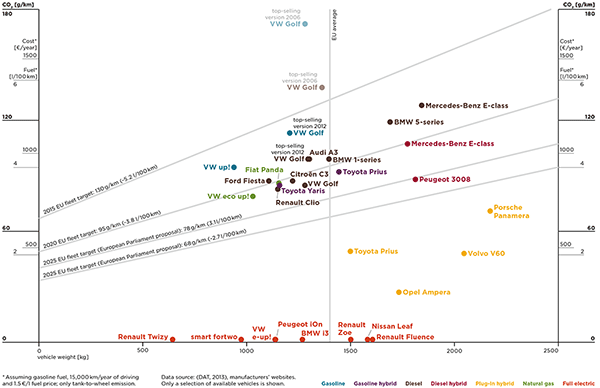Press release
Full-throttle into the future: New data should turbocharge cars CO2 debate
Statistics confirm what personal observation suggests: Efficient vehicles are available today in Europe in significant and growing numbers. And for that reason, the CO2 emissions targets for 2020 that are becoming a political football in Brussels lie within reach, notwithstanding all assertions to the contrary. These are among the conclusions to be drawn from the new edition of the European Vehicle Market Statistics Pocketbook, published today in Berlin by the International Council on Clean Transportation.
Download the report: [.pdf] [.epub]
When the CO2 emissions targets for passenger cars were coming up for a vote in the European Council last June, no one anticipated the plot twists that lay ahead in this suddenly suspenseful political story. Then German chancellor Angela Merkel personally intervened by phone to ensure that the vote was removed from the agenda. Ever since, mostly behind closed doors, European politicians have been arguing over a compromise. The clock is ticking. Experts say that an agreement must be reached before the end of this year, or a delay until after the next election of the European Parliament will be unavoidable.
Now a new edition of the statistical portrait of the European vehicle market compiled annually by the ICCT highlights just how narrow, in most instances, is the gap between current performance and the 2020 targets that the manufacturers are fighting over.
What emerges from the statistics is, in one sense, an explanation of the auto industry’s disunity. While BMW and Daimler have come under criticism for their strategy of delay, Europe’s largest vehicle manufacturer has avoided the fray. Volkswagen can afford to remain relaxed. In 1999, VW’s new Lupo embodied the eco-mobile: small, light, often painted green, with cute saucer eyes—and fuel consumption of only 3 liters per 100 kilometers. It sank in the market like a stone; only about 30,000 were sold before VW halted production in 2005. But now, little more than 10 years later, VW has jumped the 3-liter car up one vehicle segment—and the market loves it. The 2013 VW Golf 1.6 TDI consumes only 3.2 liters per 100 kilometers, while delivering 81 kilowatts of power. That equates to 85 grams of CO2 per kilometer, more than 10 percent below the 95-gram 2020 target that spurred Chancellor Merkel’s personal intercession on behalf of other German automakers though it is a full seven years away. Volkswagen has announced that it will meet its 2020 efficiency target without any delay. Apparently it will do so without any drama, either.
The CO2 targets are within reach for manufacturers of larger vehicles as well as small cars. The proposed regulation takes vehicle weight into account; for example, a Mercedes-Benz E-class will be allowed to emit significantly more CO2 than a VW Golf, even in the future. The current Daimler E-class has an official fuel consumption rating of 4.1 liters per 100 kilometers, which equates to approximately 107 grams of CO2 per kilometer—just a few short years ago an unimaginably low value for a vehicle of that size. Daimler has achieved that level of fuel efficiency by combining the diesel engine with a small electric motor. Porsche is taking the same concept one step further: its 306-kilowatt Panamera plug-in hybrid emits only 71 grams of CO2 per kilometer on the official test cycle.
A crucial underlying reason for this recent explosion of technological innovation is the European Union’s CO2 regulation for passenger cars, which sets a CO2 emissions target of 130 grams per kilometer for 2015. Industry claimed that target was unachievable, and the regulation a massive burden. But nearly all vehicle manufacturers have already reached their 2015 CO2 targets, and many are overcomplying.
“The required technologies for 2020 are already in the market”, said Dr. Peter Mock, Managing Director of ICCT Europe. “Now it is mainly about deploying the existing technologies in all vehicle segments.” The impetus toward innovation that the regulation provides, notes Mock, presents a great opportunity for European manufacturers and suppliers, who enjoy a global reputation for high-quality engineering and technically advanced vehicles. At the same time, consumers will benefit significantly, because CO2 emissions and fuel consumption are directly linked. Consumer organizations expect annual savings of about 400 Euro per vehicle by 2020, thanks to new vehicles’ lower fuel consumption.
Daimler boss Dieter Zetsche recently called the ongoing negotiations in Brussels “carpet trading.” One hopes that Europe’s politicians can soon agree to a deal, so that the carpet can finally take flight. For Europe’s global competitors are not sleeping; in the U.S., CO2 emission targets for 2025 have already been adopted, while the EU remains mired in details concerning its shorter-range plans.
Some key facts re. the EU car CO2 regulation
| 1% | Annual CO2 reduction for new cars in the EU prior to 2008 |
| 4% | Annual CO2 reduction for new cars in the EU since to 2008 |
| 5.2 L/100km | Fuel consumption of new cars in the EU today |
| 3.8 L/100km | Fuel consumption of nes cars in the EU in 2020 |
| €1000 | Required investment in new technologies to meet the 2020 target (per car) |
| €400 | Annual fuel consumption savings when 2020 target is met (per car) |
| €40 billion | Annual savings on crude oil imports into the EU when 2020 target is met |
| €33 billion | Annual income from fuel tax in Germany (for comparison) |
| 0.4% | Market share, hybrid cars, Germany, 2012 |
| 20% | Market share, hybrid cars, Japan, 2012 |
Download the report: [.pdf] [.epub]
Contact: Peter Mock, Berlin, +49 (30) 847 12 9102


